University Report: Evaluating the Albanian Economy for Investment
VerifiedAdded on 2021/06/14
|19
|4929
|30
Report
AI Summary
This report analyzes the Albanian economy, focusing on its suitability for investment. It begins with an executive summary highlighting Albania's rapid growth within the South East European (SEE) region and its potential for foreign investment. The report then delves into macroeconomic developments, including demographic details, GDP growth, unemployment rates, consumer spending, government spending, and FDI inflows. It further examines the microeconomic effects, specifically the performance of the Albanian banking industry, emphasizing governmental control and the potential for higher returns. The analysis concludes with an assessment of the institutional and economic environment, including government policies and entrepreneurial initiatives, to determine the overall investment feasibility. The report aims to guide angel investors by evaluating the relevant macroeconomic and microeconomic environments and recommending potential adjustments to investment strategies, offering a comprehensive overview of Albania's economic landscape.
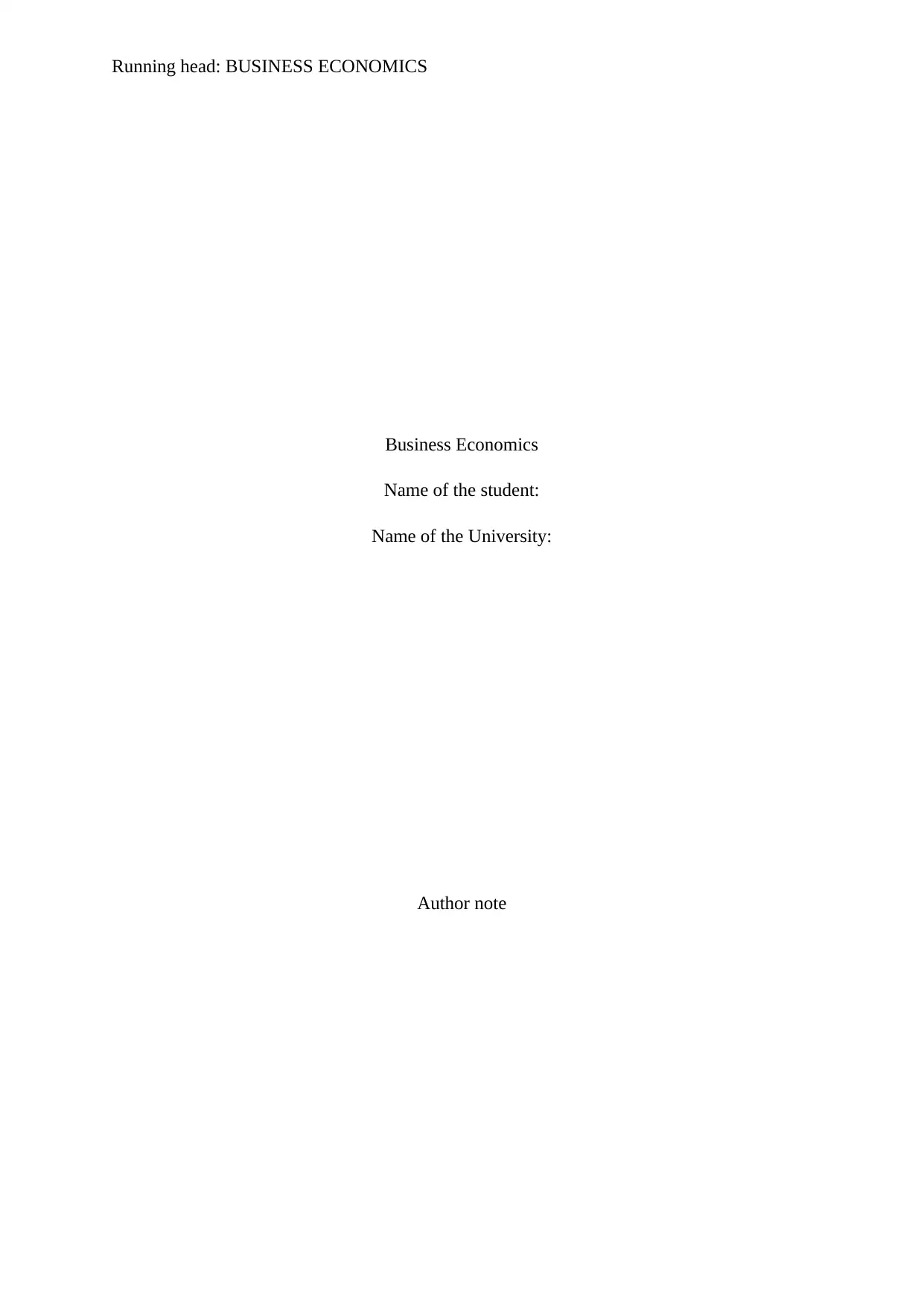
Running head: BUSINESS ECONOMICS
Business Economics
Name of the student:
Name of the University:
Author note
Business Economics
Name of the student:
Name of the University:
Author note
Paraphrase This Document
Need a fresh take? Get an instant paraphrase of this document with our AI Paraphraser
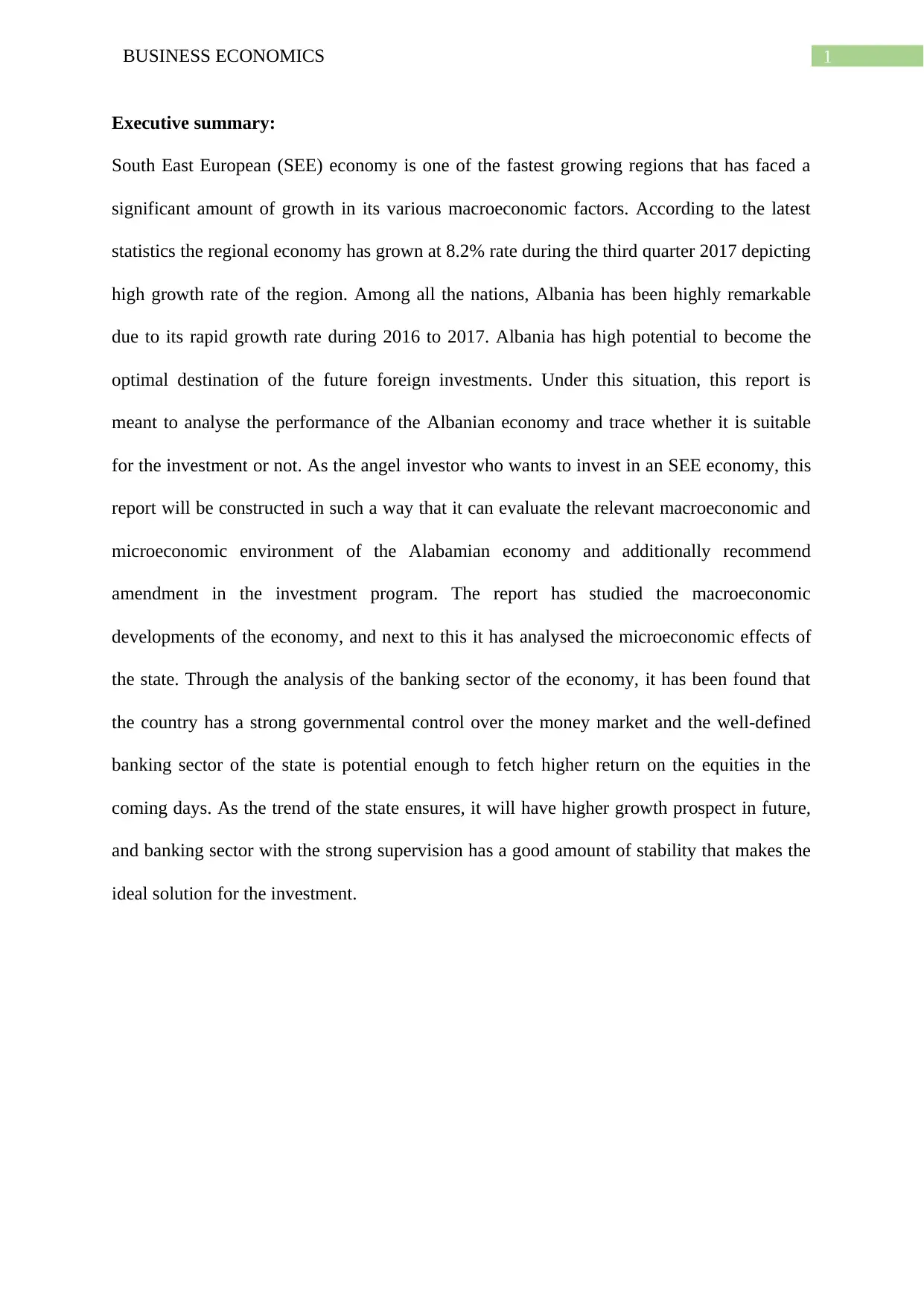
1BUSINESS ECONOMICS
Executive summary:
South East European (SEE) economy is one of the fastest growing regions that has faced a
significant amount of growth in its various macroeconomic factors. According to the latest
statistics the regional economy has grown at 8.2% rate during the third quarter 2017 depicting
high growth rate of the region. Among all the nations, Albania has been highly remarkable
due to its rapid growth rate during 2016 to 2017. Albania has high potential to become the
optimal destination of the future foreign investments. Under this situation, this report is
meant to analyse the performance of the Albanian economy and trace whether it is suitable
for the investment or not. As the angel investor who wants to invest in an SEE economy, this
report will be constructed in such a way that it can evaluate the relevant macroeconomic and
microeconomic environment of the Alabamian economy and additionally recommend
amendment in the investment program. The report has studied the macroeconomic
developments of the economy, and next to this it has analysed the microeconomic effects of
the state. Through the analysis of the banking sector of the economy, it has been found that
the country has a strong governmental control over the money market and the well-defined
banking sector of the state is potential enough to fetch higher return on the equities in the
coming days. As the trend of the state ensures, it will have higher growth prospect in future,
and banking sector with the strong supervision has a good amount of stability that makes the
ideal solution for the investment.
Executive summary:
South East European (SEE) economy is one of the fastest growing regions that has faced a
significant amount of growth in its various macroeconomic factors. According to the latest
statistics the regional economy has grown at 8.2% rate during the third quarter 2017 depicting
high growth rate of the region. Among all the nations, Albania has been highly remarkable
due to its rapid growth rate during 2016 to 2017. Albania has high potential to become the
optimal destination of the future foreign investments. Under this situation, this report is
meant to analyse the performance of the Albanian economy and trace whether it is suitable
for the investment or not. As the angel investor who wants to invest in an SEE economy, this
report will be constructed in such a way that it can evaluate the relevant macroeconomic and
microeconomic environment of the Alabamian economy and additionally recommend
amendment in the investment program. The report has studied the macroeconomic
developments of the economy, and next to this it has analysed the microeconomic effects of
the state. Through the analysis of the banking sector of the economy, it has been found that
the country has a strong governmental control over the money market and the well-defined
banking sector of the state is potential enough to fetch higher return on the equities in the
coming days. As the trend of the state ensures, it will have higher growth prospect in future,
and banking sector with the strong supervision has a good amount of stability that makes the
ideal solution for the investment.
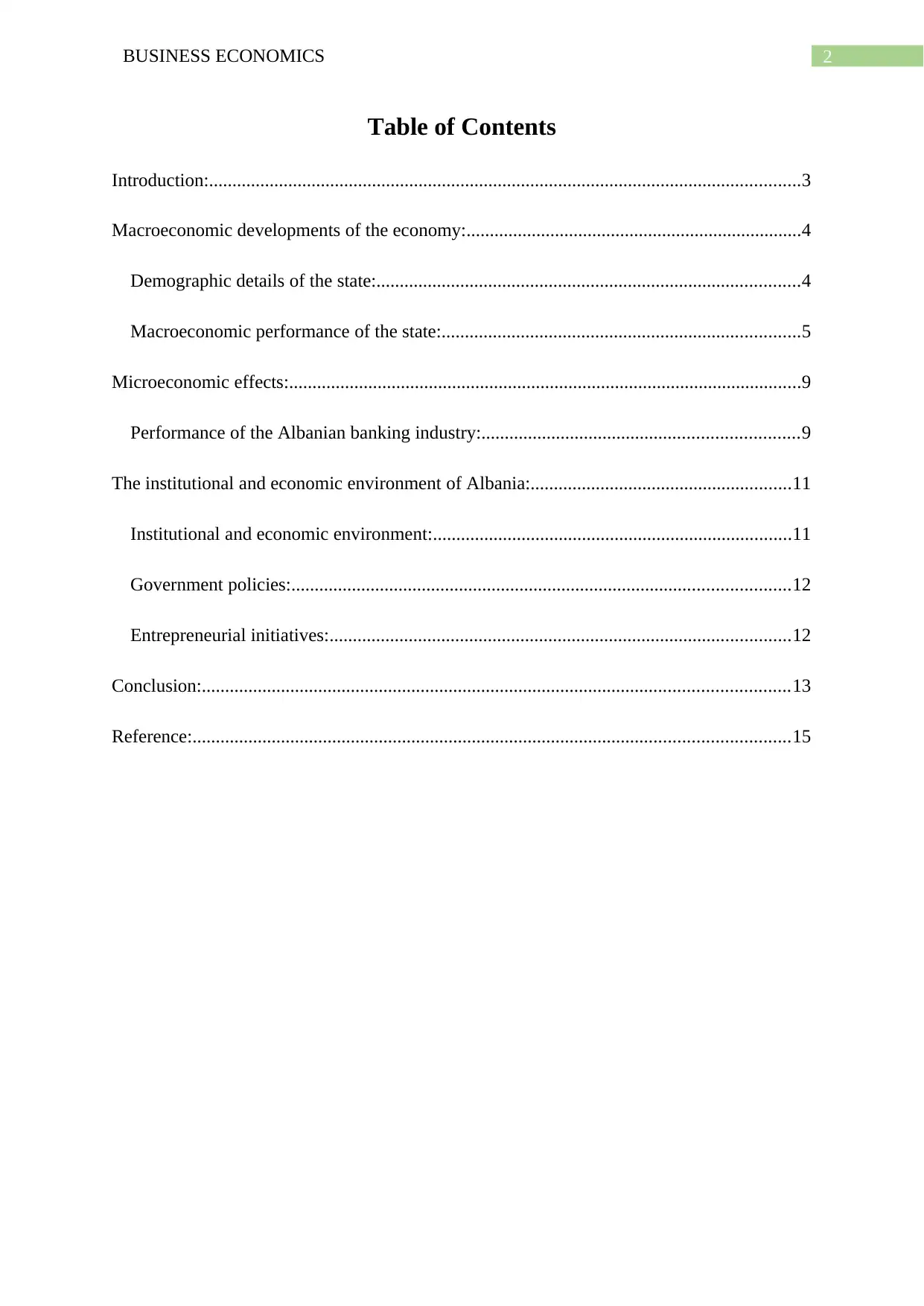
2BUSINESS ECONOMICS
Table of Contents
Introduction:...............................................................................................................................3
Macroeconomic developments of the economy:........................................................................4
Demographic details of the state:...........................................................................................4
Macroeconomic performance of the state:.............................................................................5
Microeconomic effects:..............................................................................................................9
Performance of the Albanian banking industry:....................................................................9
The institutional and economic environment of Albania:........................................................11
Institutional and economic environment:.............................................................................11
Government policies:...........................................................................................................12
Entrepreneurial initiatives:...................................................................................................12
Conclusion:..............................................................................................................................13
Reference:................................................................................................................................15
Table of Contents
Introduction:...............................................................................................................................3
Macroeconomic developments of the economy:........................................................................4
Demographic details of the state:...........................................................................................4
Macroeconomic performance of the state:.............................................................................5
Microeconomic effects:..............................................................................................................9
Performance of the Albanian banking industry:....................................................................9
The institutional and economic environment of Albania:........................................................11
Institutional and economic environment:.............................................................................11
Government policies:...........................................................................................................12
Entrepreneurial initiatives:...................................................................................................12
Conclusion:..............................................................................................................................13
Reference:................................................................................................................................15
⊘ This is a preview!⊘
Do you want full access?
Subscribe today to unlock all pages.

Trusted by 1+ million students worldwide
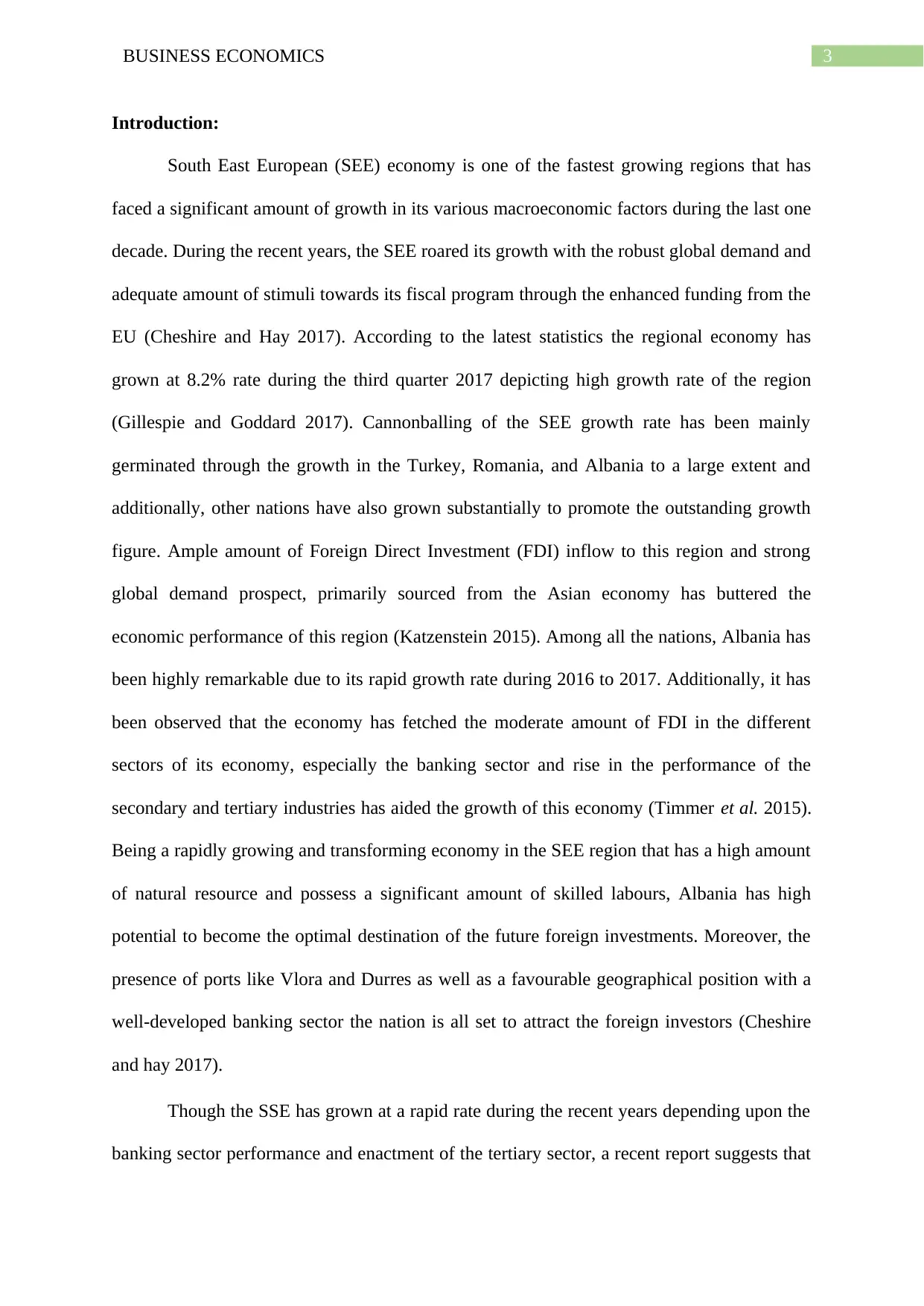
3BUSINESS ECONOMICS
Introduction:
South East European (SEE) economy is one of the fastest growing regions that has
faced a significant amount of growth in its various macroeconomic factors during the last one
decade. During the recent years, the SEE roared its growth with the robust global demand and
adequate amount of stimuli towards its fiscal program through the enhanced funding from the
EU (Cheshire and Hay 2017). According to the latest statistics the regional economy has
grown at 8.2% rate during the third quarter 2017 depicting high growth rate of the region
(Gillespie and Goddard 2017). Cannonballing of the SEE growth rate has been mainly
germinated through the growth in the Turkey, Romania, and Albania to a large extent and
additionally, other nations have also grown substantially to promote the outstanding growth
figure. Ample amount of Foreign Direct Investment (FDI) inflow to this region and strong
global demand prospect, primarily sourced from the Asian economy has buttered the
economic performance of this region (Katzenstein 2015). Among all the nations, Albania has
been highly remarkable due to its rapid growth rate during 2016 to 2017. Additionally, it has
been observed that the economy has fetched the moderate amount of FDI in the different
sectors of its economy, especially the banking sector and rise in the performance of the
secondary and tertiary industries has aided the growth of this economy (Timmer et al. 2015).
Being a rapidly growing and transforming economy in the SEE region that has a high amount
of natural resource and possess a significant amount of skilled labours, Albania has high
potential to become the optimal destination of the future foreign investments. Moreover, the
presence of ports like Vlora and Durres as well as a favourable geographical position with a
well-developed banking sector the nation is all set to attract the foreign investors (Cheshire
and hay 2017).
Though the SSE has grown at a rapid rate during the recent years depending upon the
banking sector performance and enactment of the tertiary sector, a recent report suggests that
Introduction:
South East European (SEE) economy is one of the fastest growing regions that has
faced a significant amount of growth in its various macroeconomic factors during the last one
decade. During the recent years, the SEE roared its growth with the robust global demand and
adequate amount of stimuli towards its fiscal program through the enhanced funding from the
EU (Cheshire and Hay 2017). According to the latest statistics the regional economy has
grown at 8.2% rate during the third quarter 2017 depicting high growth rate of the region
(Gillespie and Goddard 2017). Cannonballing of the SEE growth rate has been mainly
germinated through the growth in the Turkey, Romania, and Albania to a large extent and
additionally, other nations have also grown substantially to promote the outstanding growth
figure. Ample amount of Foreign Direct Investment (FDI) inflow to this region and strong
global demand prospect, primarily sourced from the Asian economy has buttered the
economic performance of this region (Katzenstein 2015). Among all the nations, Albania has
been highly remarkable due to its rapid growth rate during 2016 to 2017. Additionally, it has
been observed that the economy has fetched the moderate amount of FDI in the different
sectors of its economy, especially the banking sector and rise in the performance of the
secondary and tertiary industries has aided the growth of this economy (Timmer et al. 2015).
Being a rapidly growing and transforming economy in the SEE region that has a high amount
of natural resource and possess a significant amount of skilled labours, Albania has high
potential to become the optimal destination of the future foreign investments. Moreover, the
presence of ports like Vlora and Durres as well as a favourable geographical position with a
well-developed banking sector the nation is all set to attract the foreign investors (Cheshire
and hay 2017).
Though the SSE has grown at a rapid rate during the recent years depending upon the
banking sector performance and enactment of the tertiary sector, a recent report suggests that
Paraphrase This Document
Need a fresh take? Get an instant paraphrase of this document with our AI Paraphraser
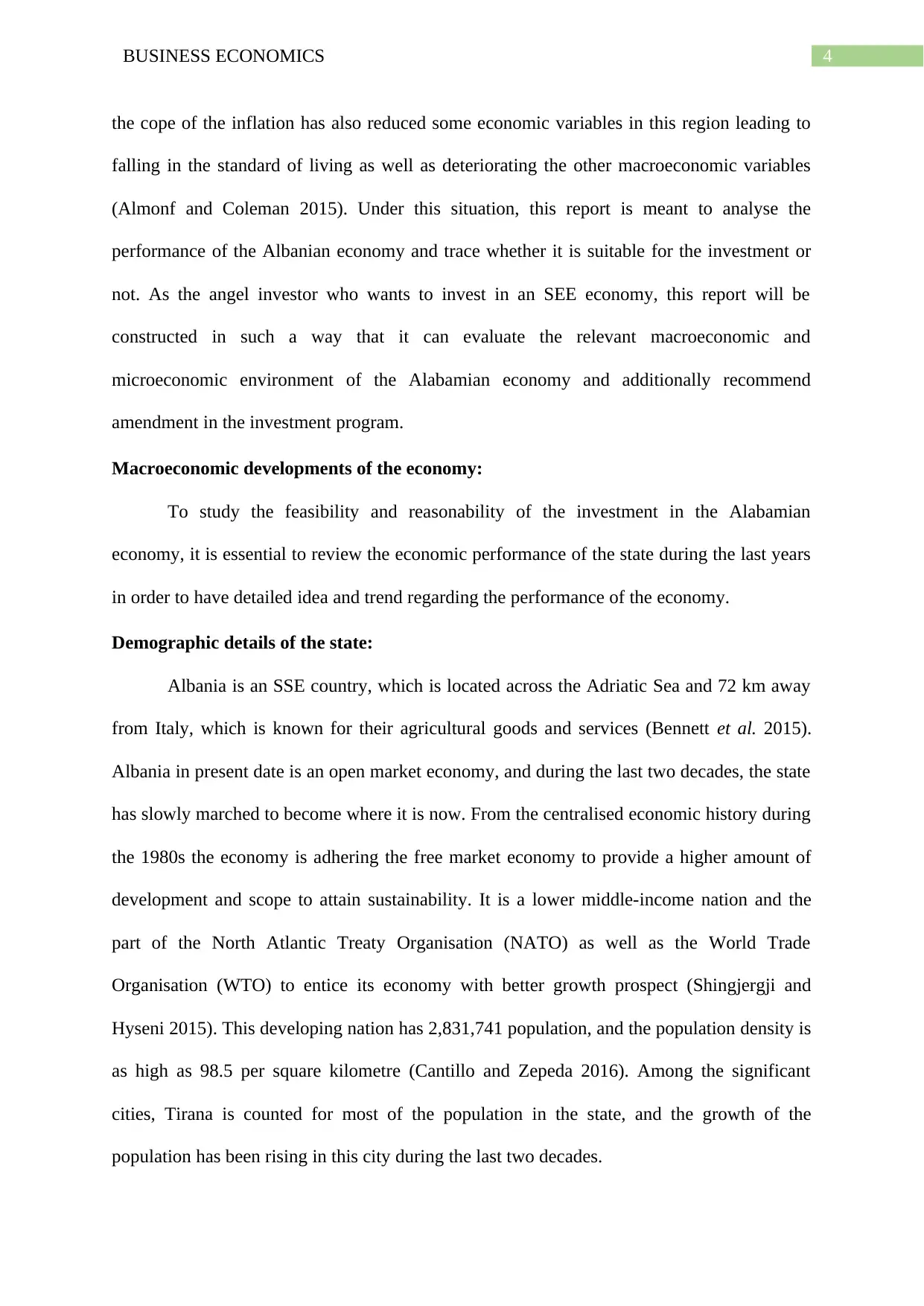
4BUSINESS ECONOMICS
the cope of the inflation has also reduced some economic variables in this region leading to
falling in the standard of living as well as deteriorating the other macroeconomic variables
(Almonf and Coleman 2015). Under this situation, this report is meant to analyse the
performance of the Albanian economy and trace whether it is suitable for the investment or
not. As the angel investor who wants to invest in an SEE economy, this report will be
constructed in such a way that it can evaluate the relevant macroeconomic and
microeconomic environment of the Alabamian economy and additionally recommend
amendment in the investment program.
Macroeconomic developments of the economy:
To study the feasibility and reasonability of the investment in the Alabamian
economy, it is essential to review the economic performance of the state during the last years
in order to have detailed idea and trend regarding the performance of the economy.
Demographic details of the state:
Albania is an SSE country, which is located across the Adriatic Sea and 72 km away
from Italy, which is known for their agricultural goods and services (Bennett et al. 2015).
Albania in present date is an open market economy, and during the last two decades, the state
has slowly marched to become where it is now. From the centralised economic history during
the 1980s the economy is adhering the free market economy to provide a higher amount of
development and scope to attain sustainability. It is a lower middle-income nation and the
part of the North Atlantic Treaty Organisation (NATO) as well as the World Trade
Organisation (WTO) to entice its economy with better growth prospect (Shingjergji and
Hyseni 2015). This developing nation has 2,831,741 population, and the population density is
as high as 98.5 per square kilometre (Cantillo and Zepeda 2016). Among the significant
cities, Tirana is counted for most of the population in the state, and the growth of the
population has been rising in this city during the last two decades.
the cope of the inflation has also reduced some economic variables in this region leading to
falling in the standard of living as well as deteriorating the other macroeconomic variables
(Almonf and Coleman 2015). Under this situation, this report is meant to analyse the
performance of the Albanian economy and trace whether it is suitable for the investment or
not. As the angel investor who wants to invest in an SEE economy, this report will be
constructed in such a way that it can evaluate the relevant macroeconomic and
microeconomic environment of the Alabamian economy and additionally recommend
amendment in the investment program.
Macroeconomic developments of the economy:
To study the feasibility and reasonability of the investment in the Alabamian
economy, it is essential to review the economic performance of the state during the last years
in order to have detailed idea and trend regarding the performance of the economy.
Demographic details of the state:
Albania is an SSE country, which is located across the Adriatic Sea and 72 km away
from Italy, which is known for their agricultural goods and services (Bennett et al. 2015).
Albania in present date is an open market economy, and during the last two decades, the state
has slowly marched to become where it is now. From the centralised economic history during
the 1980s the economy is adhering the free market economy to provide a higher amount of
development and scope to attain sustainability. It is a lower middle-income nation and the
part of the North Atlantic Treaty Organisation (NATO) as well as the World Trade
Organisation (WTO) to entice its economy with better growth prospect (Shingjergji and
Hyseni 2015). This developing nation has 2,831,741 population, and the population density is
as high as 98.5 per square kilometre (Cantillo and Zepeda 2016). Among the significant
cities, Tirana is counted for most of the population in the state, and the growth of the
population has been rising in this city during the last two decades.
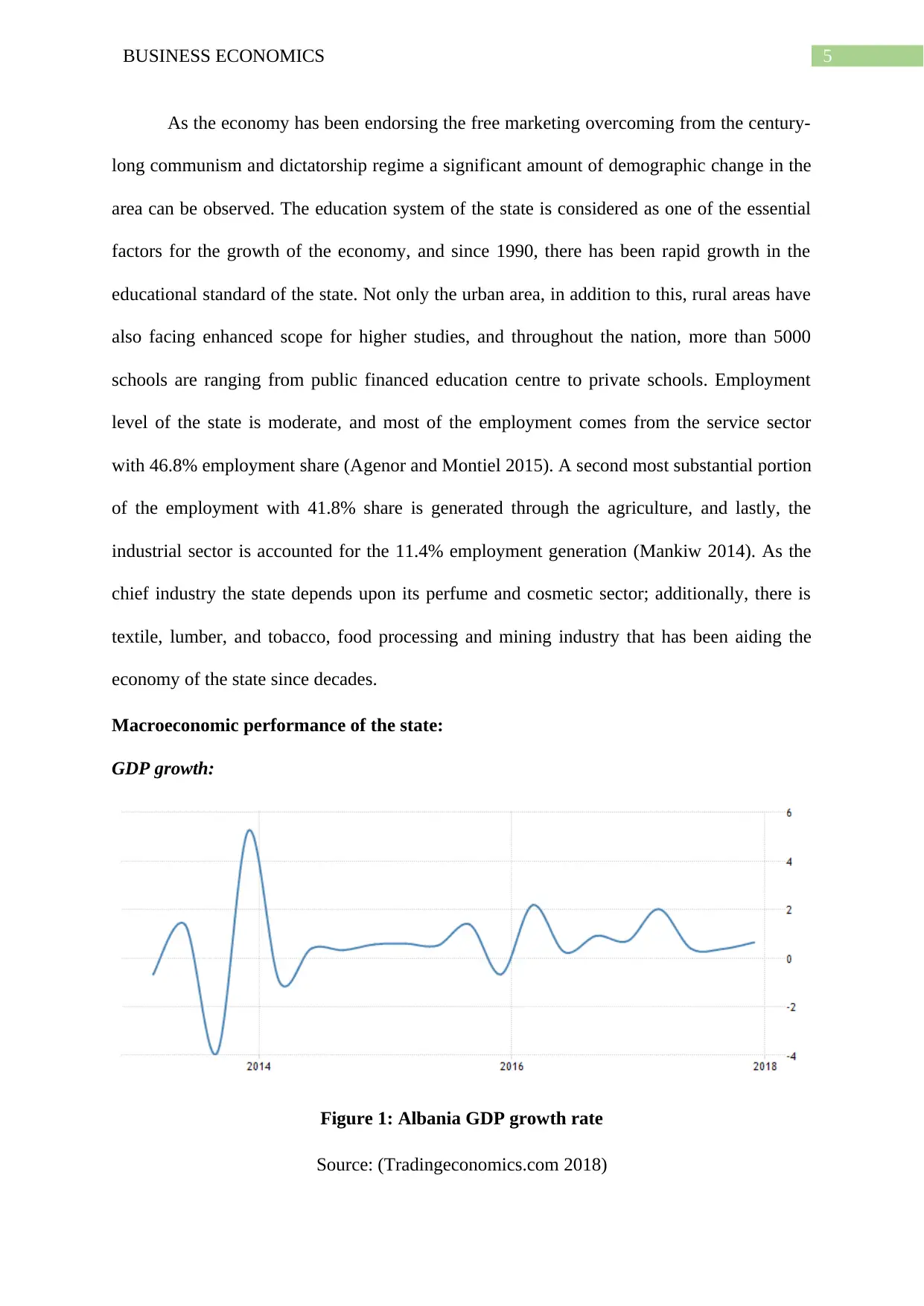
5BUSINESS ECONOMICS
As the economy has been endorsing the free marketing overcoming from the century-
long communism and dictatorship regime a significant amount of demographic change in the
area can be observed. The education system of the state is considered as one of the essential
factors for the growth of the economy, and since 1990, there has been rapid growth in the
educational standard of the state. Not only the urban area, in addition to this, rural areas have
also facing enhanced scope for higher studies, and throughout the nation, more than 5000
schools are ranging from public financed education centre to private schools. Employment
level of the state is moderate, and most of the employment comes from the service sector
with 46.8% employment share (Agenor and Montiel 2015). A second most substantial portion
of the employment with 41.8% share is generated through the agriculture, and lastly, the
industrial sector is accounted for the 11.4% employment generation (Mankiw 2014). As the
chief industry the state depends upon its perfume and cosmetic sector; additionally, there is
textile, lumber, and tobacco, food processing and mining industry that has been aiding the
economy of the state since decades.
Macroeconomic performance of the state:
GDP growth:
Figure 1: Albania GDP growth rate
Source: (Tradingeconomics.com 2018)
As the economy has been endorsing the free marketing overcoming from the century-
long communism and dictatorship regime a significant amount of demographic change in the
area can be observed. The education system of the state is considered as one of the essential
factors for the growth of the economy, and since 1990, there has been rapid growth in the
educational standard of the state. Not only the urban area, in addition to this, rural areas have
also facing enhanced scope for higher studies, and throughout the nation, more than 5000
schools are ranging from public financed education centre to private schools. Employment
level of the state is moderate, and most of the employment comes from the service sector
with 46.8% employment share (Agenor and Montiel 2015). A second most substantial portion
of the employment with 41.8% share is generated through the agriculture, and lastly, the
industrial sector is accounted for the 11.4% employment generation (Mankiw 2014). As the
chief industry the state depends upon its perfume and cosmetic sector; additionally, there is
textile, lumber, and tobacco, food processing and mining industry that has been aiding the
economy of the state since decades.
Macroeconomic performance of the state:
GDP growth:
Figure 1: Albania GDP growth rate
Source: (Tradingeconomics.com 2018)
⊘ This is a preview!⊘
Do you want full access?
Subscribe today to unlock all pages.

Trusted by 1+ million students worldwide
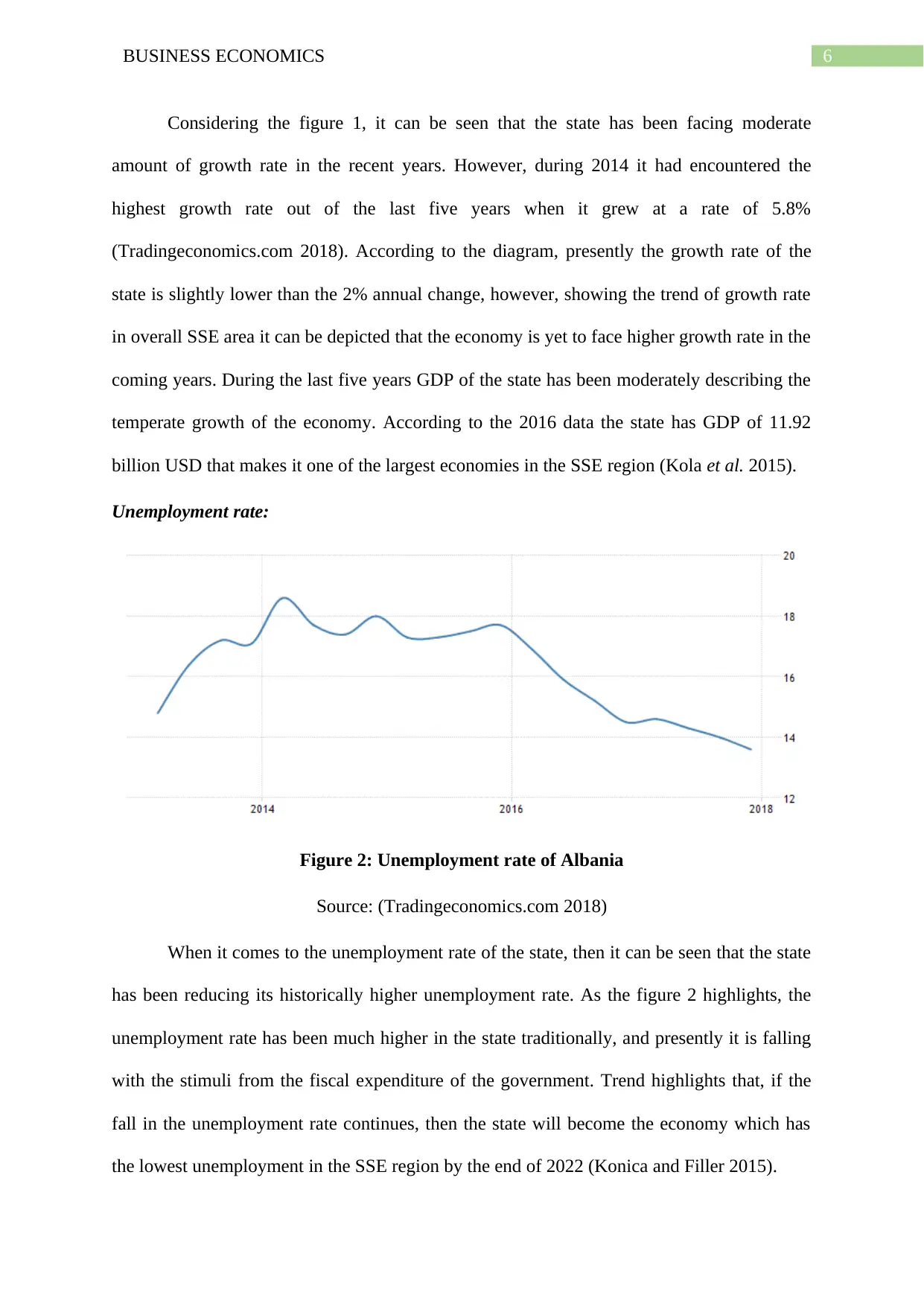
6BUSINESS ECONOMICS
Considering the figure 1, it can be seen that the state has been facing moderate
amount of growth rate in the recent years. However, during 2014 it had encountered the
highest growth rate out of the last five years when it grew at a rate of 5.8%
(Tradingeconomics.com 2018). According to the diagram, presently the growth rate of the
state is slightly lower than the 2% annual change, however, showing the trend of growth rate
in overall SSE area it can be depicted that the economy is yet to face higher growth rate in the
coming years. During the last five years GDP of the state has been moderately describing the
temperate growth of the economy. According to the 2016 data the state has GDP of 11.92
billion USD that makes it one of the largest economies in the SSE region (Kola et al. 2015).
Unemployment rate:
Figure 2: Unemployment rate of Albania
Source: (Tradingeconomics.com 2018)
When it comes to the unemployment rate of the state, then it can be seen that the state
has been reducing its historically higher unemployment rate. As the figure 2 highlights, the
unemployment rate has been much higher in the state traditionally, and presently it is falling
with the stimuli from the fiscal expenditure of the government. Trend highlights that, if the
fall in the unemployment rate continues, then the state will become the economy which has
the lowest unemployment in the SSE region by the end of 2022 (Konica and Filler 2015).
Considering the figure 1, it can be seen that the state has been facing moderate
amount of growth rate in the recent years. However, during 2014 it had encountered the
highest growth rate out of the last five years when it grew at a rate of 5.8%
(Tradingeconomics.com 2018). According to the diagram, presently the growth rate of the
state is slightly lower than the 2% annual change, however, showing the trend of growth rate
in overall SSE area it can be depicted that the economy is yet to face higher growth rate in the
coming years. During the last five years GDP of the state has been moderately describing the
temperate growth of the economy. According to the 2016 data the state has GDP of 11.92
billion USD that makes it one of the largest economies in the SSE region (Kola et al. 2015).
Unemployment rate:
Figure 2: Unemployment rate of Albania
Source: (Tradingeconomics.com 2018)
When it comes to the unemployment rate of the state, then it can be seen that the state
has been reducing its historically higher unemployment rate. As the figure 2 highlights, the
unemployment rate has been much higher in the state traditionally, and presently it is falling
with the stimuli from the fiscal expenditure of the government. Trend highlights that, if the
fall in the unemployment rate continues, then the state will become the economy which has
the lowest unemployment in the SSE region by the end of 2022 (Konica and Filler 2015).
Paraphrase This Document
Need a fresh take? Get an instant paraphrase of this document with our AI Paraphraser
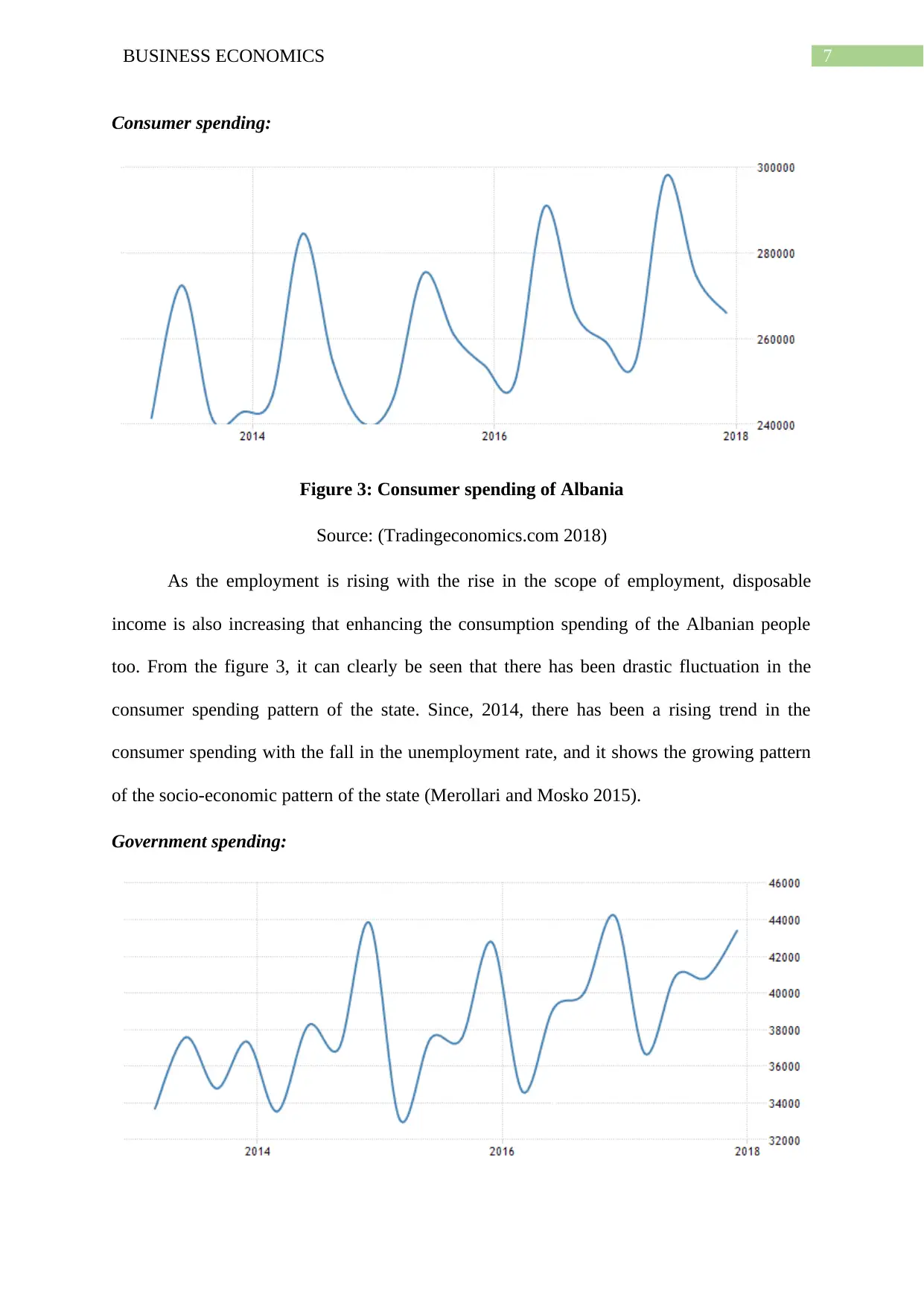
7BUSINESS ECONOMICS
Consumer spending:
Figure 3: Consumer spending of Albania
Source: (Tradingeconomics.com 2018)
As the employment is rising with the rise in the scope of employment, disposable
income is also increasing that enhancing the consumption spending of the Albanian people
too. From the figure 3, it can clearly be seen that there has been drastic fluctuation in the
consumer spending pattern of the state. Since, 2014, there has been a rising trend in the
consumer spending with the fall in the unemployment rate, and it shows the growing pattern
of the socio-economic pattern of the state (Merollari and Mosko 2015).
Government spending:
Consumer spending:
Figure 3: Consumer spending of Albania
Source: (Tradingeconomics.com 2018)
As the employment is rising with the rise in the scope of employment, disposable
income is also increasing that enhancing the consumption spending of the Albanian people
too. From the figure 3, it can clearly be seen that there has been drastic fluctuation in the
consumer spending pattern of the state. Since, 2014, there has been a rising trend in the
consumer spending with the fall in the unemployment rate, and it shows the growing pattern
of the socio-economic pattern of the state (Merollari and Mosko 2015).
Government spending:
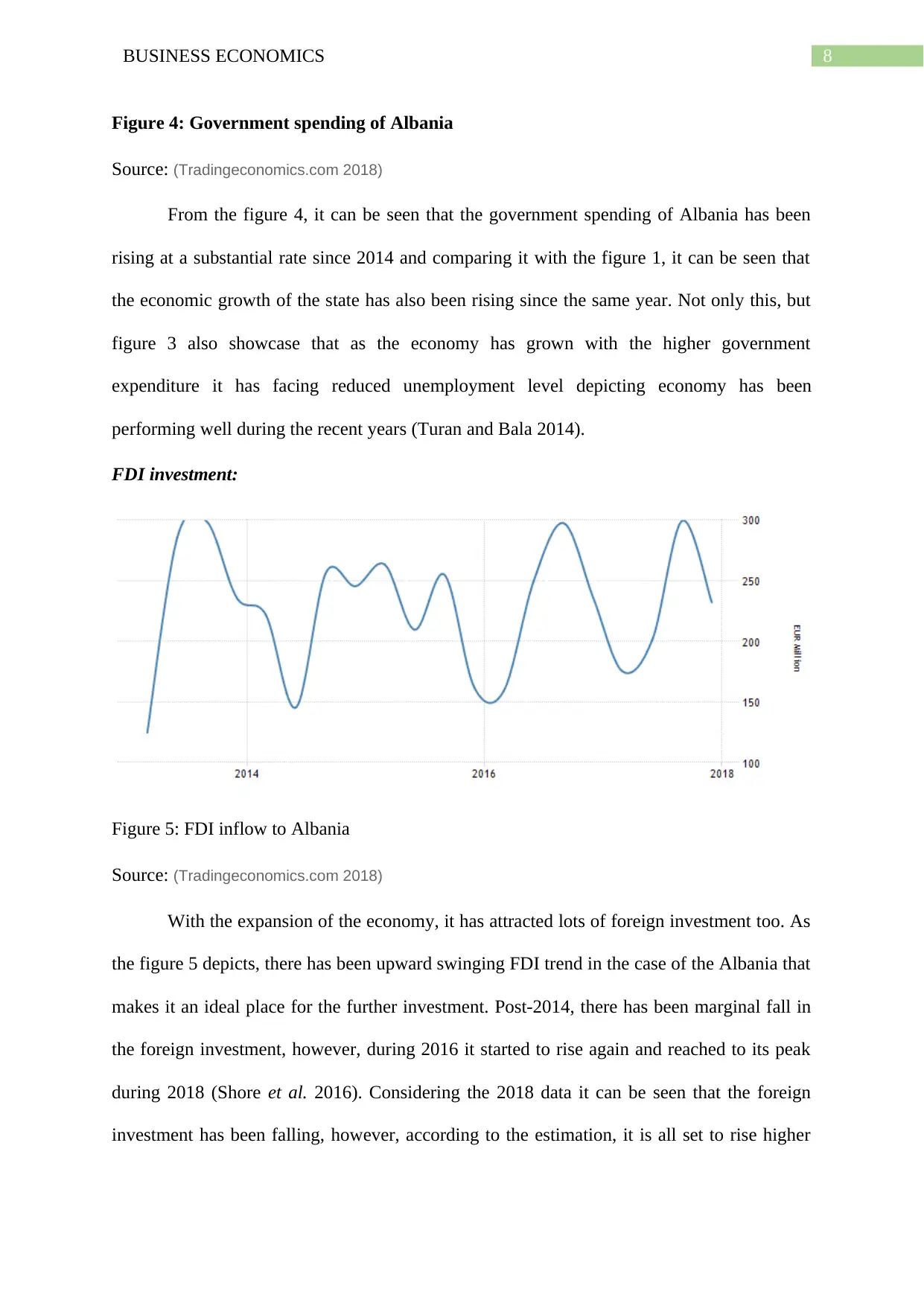
8BUSINESS ECONOMICS
Figure 4: Government spending of Albania
Source: (Tradingeconomics.com 2018)
From the figure 4, it can be seen that the government spending of Albania has been
rising at a substantial rate since 2014 and comparing it with the figure 1, it can be seen that
the economic growth of the state has also been rising since the same year. Not only this, but
figure 3 also showcase that as the economy has grown with the higher government
expenditure it has facing reduced unemployment level depicting economy has been
performing well during the recent years (Turan and Bala 2014).
FDI investment:
Figure 5: FDI inflow to Albania
Source: (Tradingeconomics.com 2018)
With the expansion of the economy, it has attracted lots of foreign investment too. As
the figure 5 depicts, there has been upward swinging FDI trend in the case of the Albania that
makes it an ideal place for the further investment. Post-2014, there has been marginal fall in
the foreign investment, however, during 2016 it started to rise again and reached to its peak
during 2018 (Shore et al. 2016). Considering the 2018 data it can be seen that the foreign
investment has been falling, however, according to the estimation, it is all set to rise higher
Figure 4: Government spending of Albania
Source: (Tradingeconomics.com 2018)
From the figure 4, it can be seen that the government spending of Albania has been
rising at a substantial rate since 2014 and comparing it with the figure 1, it can be seen that
the economic growth of the state has also been rising since the same year. Not only this, but
figure 3 also showcase that as the economy has grown with the higher government
expenditure it has facing reduced unemployment level depicting economy has been
performing well during the recent years (Turan and Bala 2014).
FDI investment:
Figure 5: FDI inflow to Albania
Source: (Tradingeconomics.com 2018)
With the expansion of the economy, it has attracted lots of foreign investment too. As
the figure 5 depicts, there has been upward swinging FDI trend in the case of the Albania that
makes it an ideal place for the further investment. Post-2014, there has been marginal fall in
the foreign investment, however, during 2016 it started to rise again and reached to its peak
during 2018 (Shore et al. 2016). Considering the 2018 data it can be seen that the foreign
investment has been falling, however, according to the estimation, it is all set to rise higher
⊘ This is a preview!⊘
Do you want full access?
Subscribe today to unlock all pages.

Trusted by 1+ million students worldwide
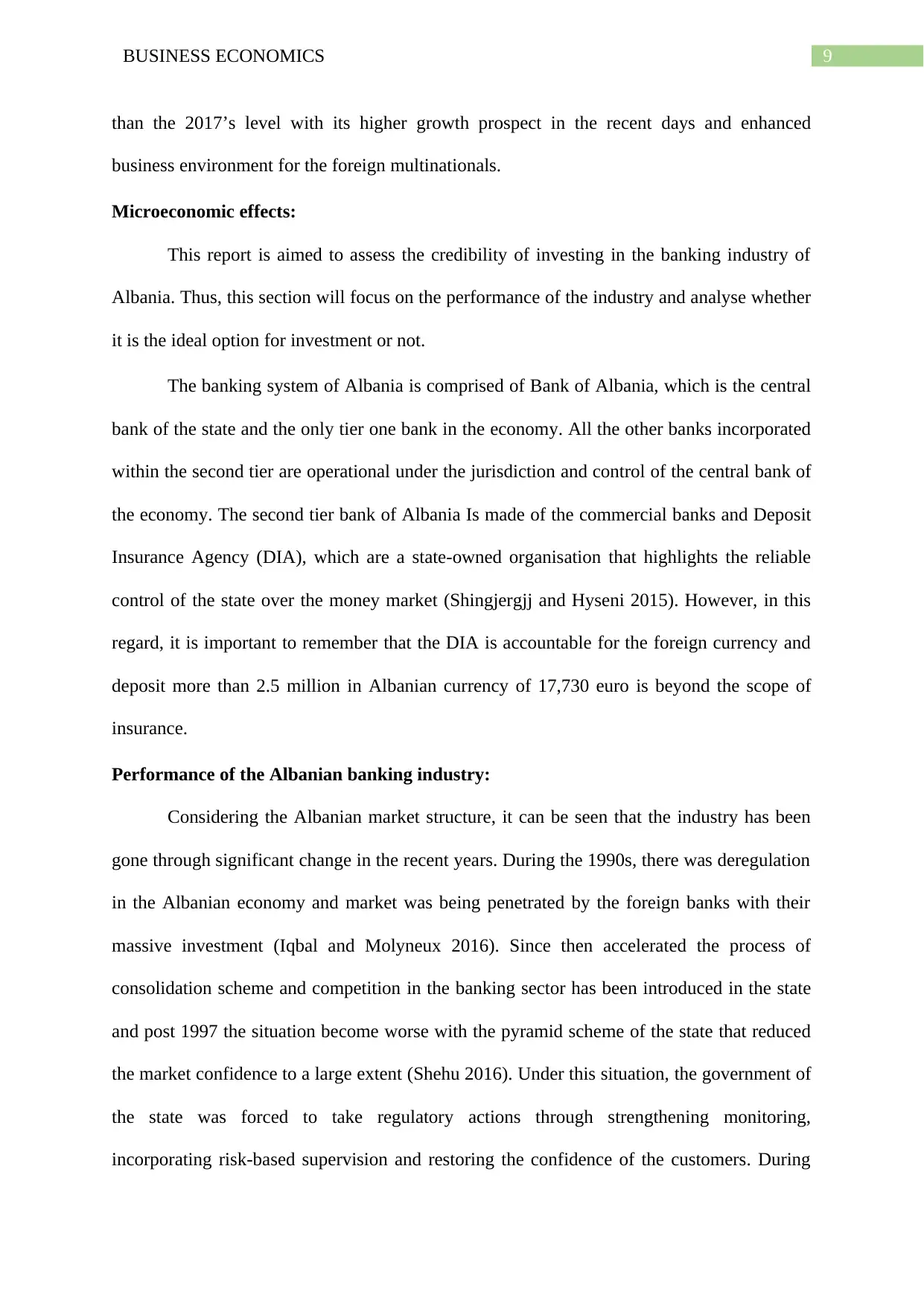
9BUSINESS ECONOMICS
than the 2017’s level with its higher growth prospect in the recent days and enhanced
business environment for the foreign multinationals.
Microeconomic effects:
This report is aimed to assess the credibility of investing in the banking industry of
Albania. Thus, this section will focus on the performance of the industry and analyse whether
it is the ideal option for investment or not.
The banking system of Albania is comprised of Bank of Albania, which is the central
bank of the state and the only tier one bank in the economy. All the other banks incorporated
within the second tier are operational under the jurisdiction and control of the central bank of
the economy. The second tier bank of Albania Is made of the commercial banks and Deposit
Insurance Agency (DIA), which are a state-owned organisation that highlights the reliable
control of the state over the money market (Shingjergjj and Hyseni 2015). However, in this
regard, it is important to remember that the DIA is accountable for the foreign currency and
deposit more than 2.5 million in Albanian currency of 17,730 euro is beyond the scope of
insurance.
Performance of the Albanian banking industry:
Considering the Albanian market structure, it can be seen that the industry has been
gone through significant change in the recent years. During the 1990s, there was deregulation
in the Albanian economy and market was being penetrated by the foreign banks with their
massive investment (Iqbal and Molyneux 2016). Since then accelerated the process of
consolidation scheme and competition in the banking sector has been introduced in the state
and post 1997 the situation become worse with the pyramid scheme of the state that reduced
the market confidence to a large extent (Shehu 2016). Under this situation, the government of
the state was forced to take regulatory actions through strengthening monitoring,
incorporating risk-based supervision and restoring the confidence of the customers. During
than the 2017’s level with its higher growth prospect in the recent days and enhanced
business environment for the foreign multinationals.
Microeconomic effects:
This report is aimed to assess the credibility of investing in the banking industry of
Albania. Thus, this section will focus on the performance of the industry and analyse whether
it is the ideal option for investment or not.
The banking system of Albania is comprised of Bank of Albania, which is the central
bank of the state and the only tier one bank in the economy. All the other banks incorporated
within the second tier are operational under the jurisdiction and control of the central bank of
the economy. The second tier bank of Albania Is made of the commercial banks and Deposit
Insurance Agency (DIA), which are a state-owned organisation that highlights the reliable
control of the state over the money market (Shingjergjj and Hyseni 2015). However, in this
regard, it is important to remember that the DIA is accountable for the foreign currency and
deposit more than 2.5 million in Albanian currency of 17,730 euro is beyond the scope of
insurance.
Performance of the Albanian banking industry:
Considering the Albanian market structure, it can be seen that the industry has been
gone through significant change in the recent years. During the 1990s, there was deregulation
in the Albanian economy and market was being penetrated by the foreign banks with their
massive investment (Iqbal and Molyneux 2016). Since then accelerated the process of
consolidation scheme and competition in the banking sector has been introduced in the state
and post 1997 the situation become worse with the pyramid scheme of the state that reduced
the market confidence to a large extent (Shehu 2016). Under this situation, the government of
the state was forced to take regulatory actions through strengthening monitoring,
incorporating risk-based supervision and restoring the confidence of the customers. During
Paraphrase This Document
Need a fresh take? Get an instant paraphrase of this document with our AI Paraphraser
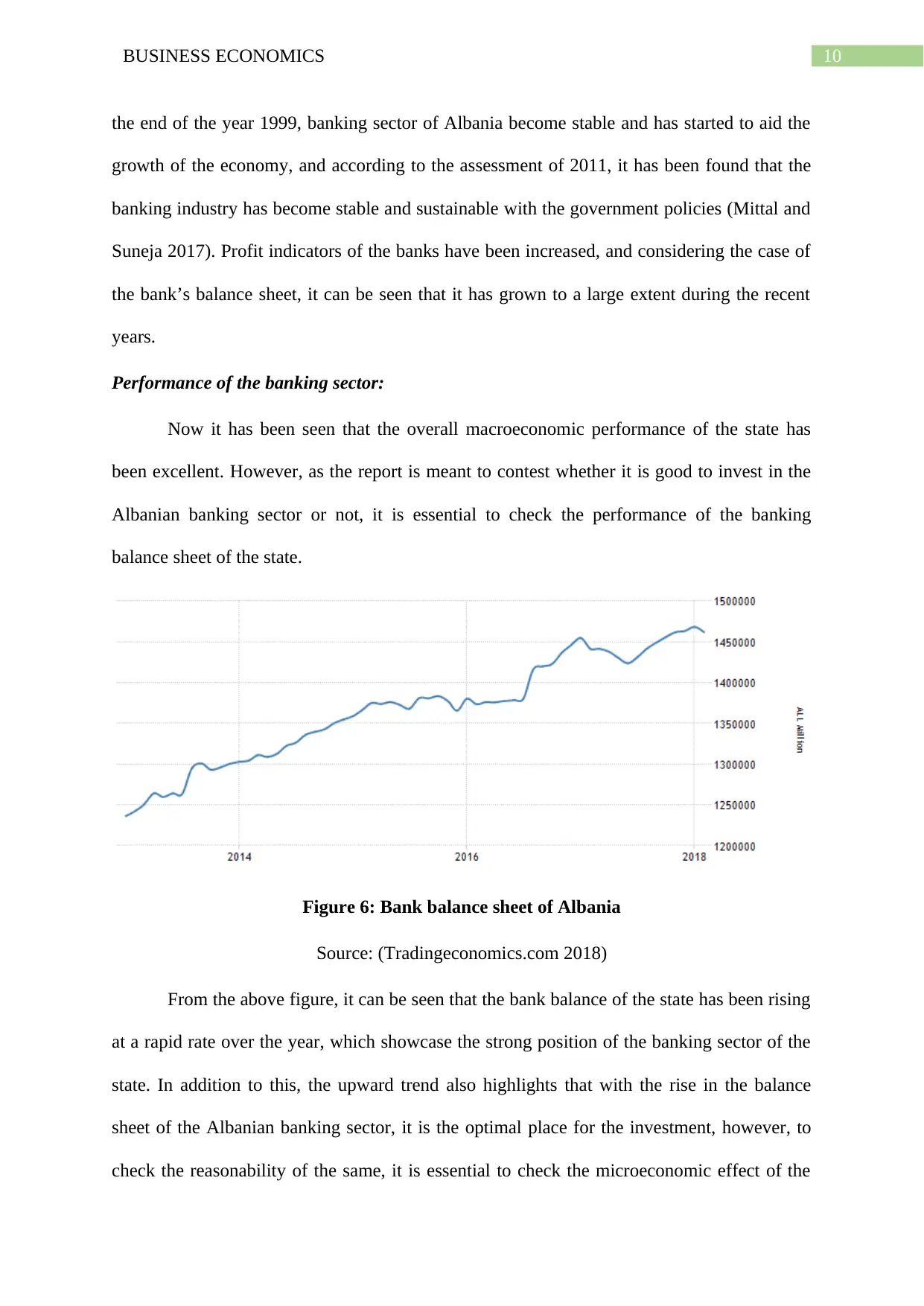
10BUSINESS ECONOMICS
the end of the year 1999, banking sector of Albania become stable and has started to aid the
growth of the economy, and according to the assessment of 2011, it has been found that the
banking industry has become stable and sustainable with the government policies (Mittal and
Suneja 2017). Profit indicators of the banks have been increased, and considering the case of
the bank’s balance sheet, it can be seen that it has grown to a large extent during the recent
years.
Performance of the banking sector:
Now it has been seen that the overall macroeconomic performance of the state has
been excellent. However, as the report is meant to contest whether it is good to invest in the
Albanian banking sector or not, it is essential to check the performance of the banking
balance sheet of the state.
Figure 6: Bank balance sheet of Albania
Source: (Tradingeconomics.com 2018)
From the above figure, it can be seen that the bank balance of the state has been rising
at a rapid rate over the year, which showcase the strong position of the banking sector of the
state. In addition to this, the upward trend also highlights that with the rise in the balance
sheet of the Albanian banking sector, it is the optimal place for the investment, however, to
check the reasonability of the same, it is essential to check the microeconomic effect of the
the end of the year 1999, banking sector of Albania become stable and has started to aid the
growth of the economy, and according to the assessment of 2011, it has been found that the
banking industry has become stable and sustainable with the government policies (Mittal and
Suneja 2017). Profit indicators of the banks have been increased, and considering the case of
the bank’s balance sheet, it can be seen that it has grown to a large extent during the recent
years.
Performance of the banking sector:
Now it has been seen that the overall macroeconomic performance of the state has
been excellent. However, as the report is meant to contest whether it is good to invest in the
Albanian banking sector or not, it is essential to check the performance of the banking
balance sheet of the state.
Figure 6: Bank balance sheet of Albania
Source: (Tradingeconomics.com 2018)
From the above figure, it can be seen that the bank balance of the state has been rising
at a rapid rate over the year, which showcase the strong position of the banking sector of the
state. In addition to this, the upward trend also highlights that with the rise in the balance
sheet of the Albanian banking sector, it is the optimal place for the investment, however, to
check the reasonability of the same, it is essential to check the microeconomic effect of the
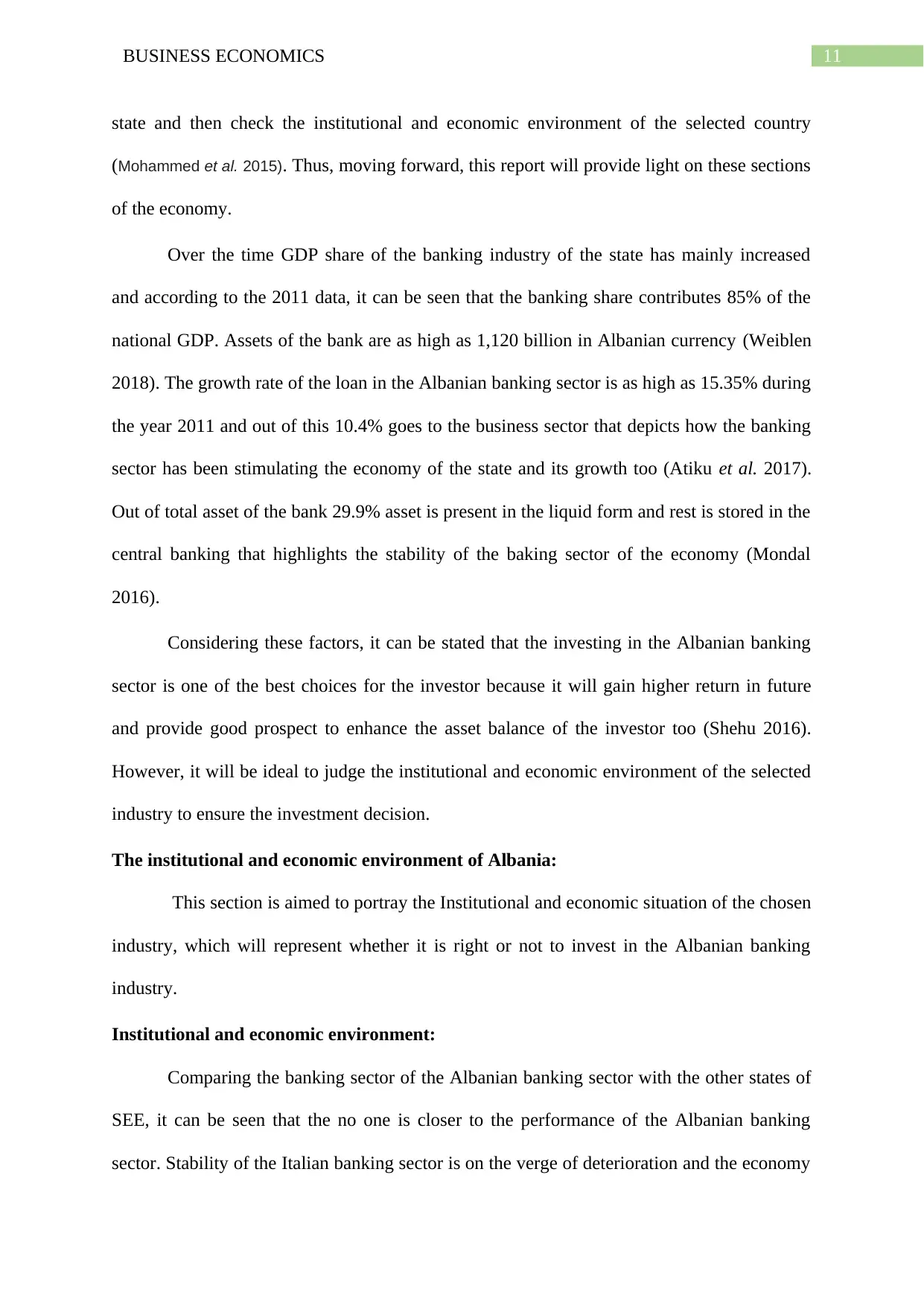
11BUSINESS ECONOMICS
state and then check the institutional and economic environment of the selected country
(Mohammed et al. 2015). Thus, moving forward, this report will provide light on these sections
of the economy.
Over the time GDP share of the banking industry of the state has mainly increased
and according to the 2011 data, it can be seen that the banking share contributes 85% of the
national GDP. Assets of the bank are as high as 1,120 billion in Albanian currency (Weiblen
2018). The growth rate of the loan in the Albanian banking sector is as high as 15.35% during
the year 2011 and out of this 10.4% goes to the business sector that depicts how the banking
sector has been stimulating the economy of the state and its growth too (Atiku et al. 2017).
Out of total asset of the bank 29.9% asset is present in the liquid form and rest is stored in the
central banking that highlights the stability of the baking sector of the economy (Mondal
2016).
Considering these factors, it can be stated that the investing in the Albanian banking
sector is one of the best choices for the investor because it will gain higher return in future
and provide good prospect to enhance the asset balance of the investor too (Shehu 2016).
However, it will be ideal to judge the institutional and economic environment of the selected
industry to ensure the investment decision.
The institutional and economic environment of Albania:
This section is aimed to portray the Institutional and economic situation of the chosen
industry, which will represent whether it is right or not to invest in the Albanian banking
industry.
Institutional and economic environment:
Comparing the banking sector of the Albanian banking sector with the other states of
SEE, it can be seen that the no one is closer to the performance of the Albanian banking
sector. Stability of the Italian banking sector is on the verge of deterioration and the economy
state and then check the institutional and economic environment of the selected country
(Mohammed et al. 2015). Thus, moving forward, this report will provide light on these sections
of the economy.
Over the time GDP share of the banking industry of the state has mainly increased
and according to the 2011 data, it can be seen that the banking share contributes 85% of the
national GDP. Assets of the bank are as high as 1,120 billion in Albanian currency (Weiblen
2018). The growth rate of the loan in the Albanian banking sector is as high as 15.35% during
the year 2011 and out of this 10.4% goes to the business sector that depicts how the banking
sector has been stimulating the economy of the state and its growth too (Atiku et al. 2017).
Out of total asset of the bank 29.9% asset is present in the liquid form and rest is stored in the
central banking that highlights the stability of the baking sector of the economy (Mondal
2016).
Considering these factors, it can be stated that the investing in the Albanian banking
sector is one of the best choices for the investor because it will gain higher return in future
and provide good prospect to enhance the asset balance of the investor too (Shehu 2016).
However, it will be ideal to judge the institutional and economic environment of the selected
industry to ensure the investment decision.
The institutional and economic environment of Albania:
This section is aimed to portray the Institutional and economic situation of the chosen
industry, which will represent whether it is right or not to invest in the Albanian banking
industry.
Institutional and economic environment:
Comparing the banking sector of the Albanian banking sector with the other states of
SEE, it can be seen that the no one is closer to the performance of the Albanian banking
sector. Stability of the Italian banking sector is on the verge of deterioration and the economy
⊘ This is a preview!⊘
Do you want full access?
Subscribe today to unlock all pages.

Trusted by 1+ million students worldwide
1 out of 19
Related Documents
Your All-in-One AI-Powered Toolkit for Academic Success.
+13062052269
info@desklib.com
Available 24*7 on WhatsApp / Email
![[object Object]](/_next/static/media/star-bottom.7253800d.svg)
Unlock your academic potential
Copyright © 2020–2025 A2Z Services. All Rights Reserved. Developed and managed by ZUCOL.





